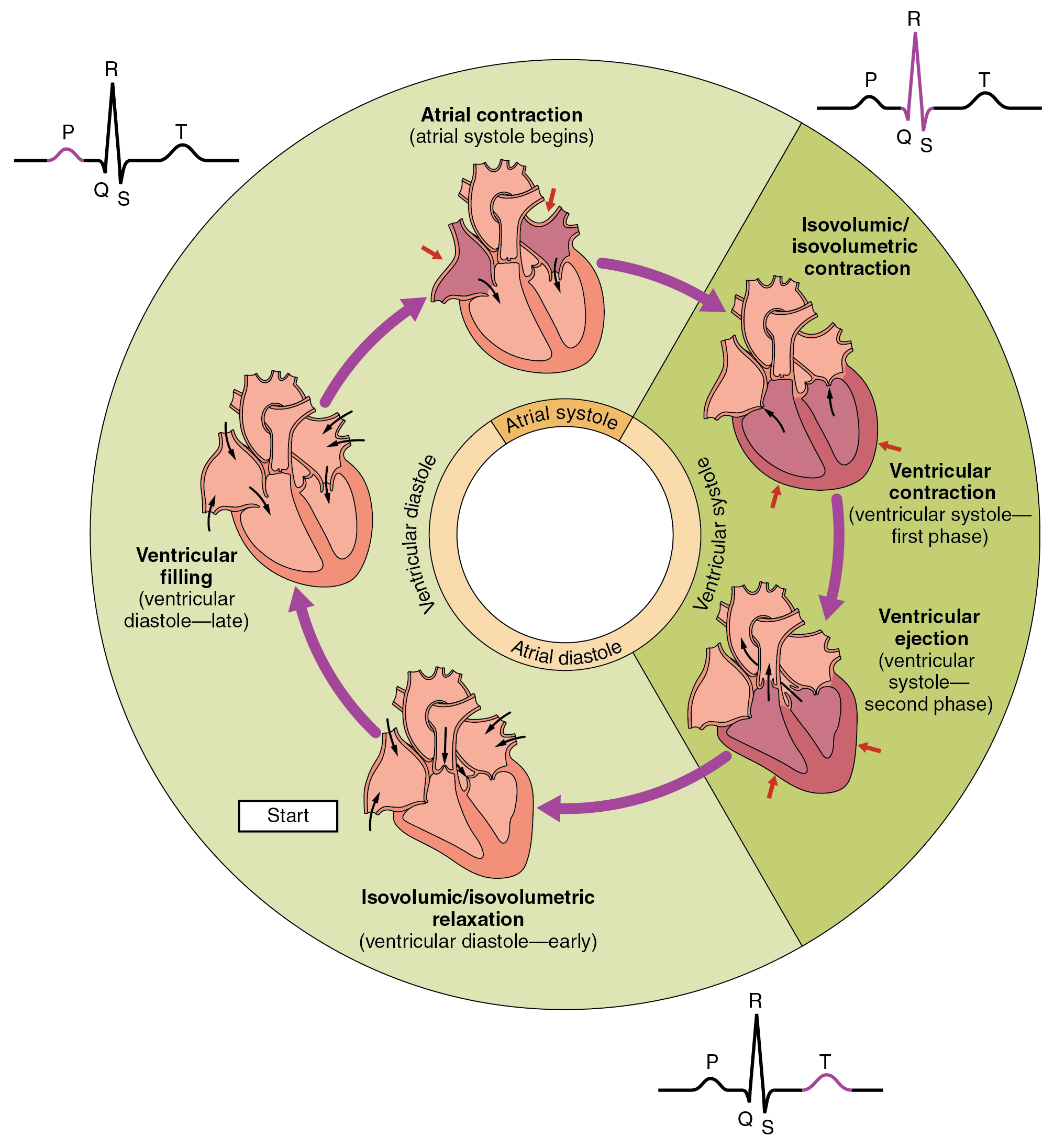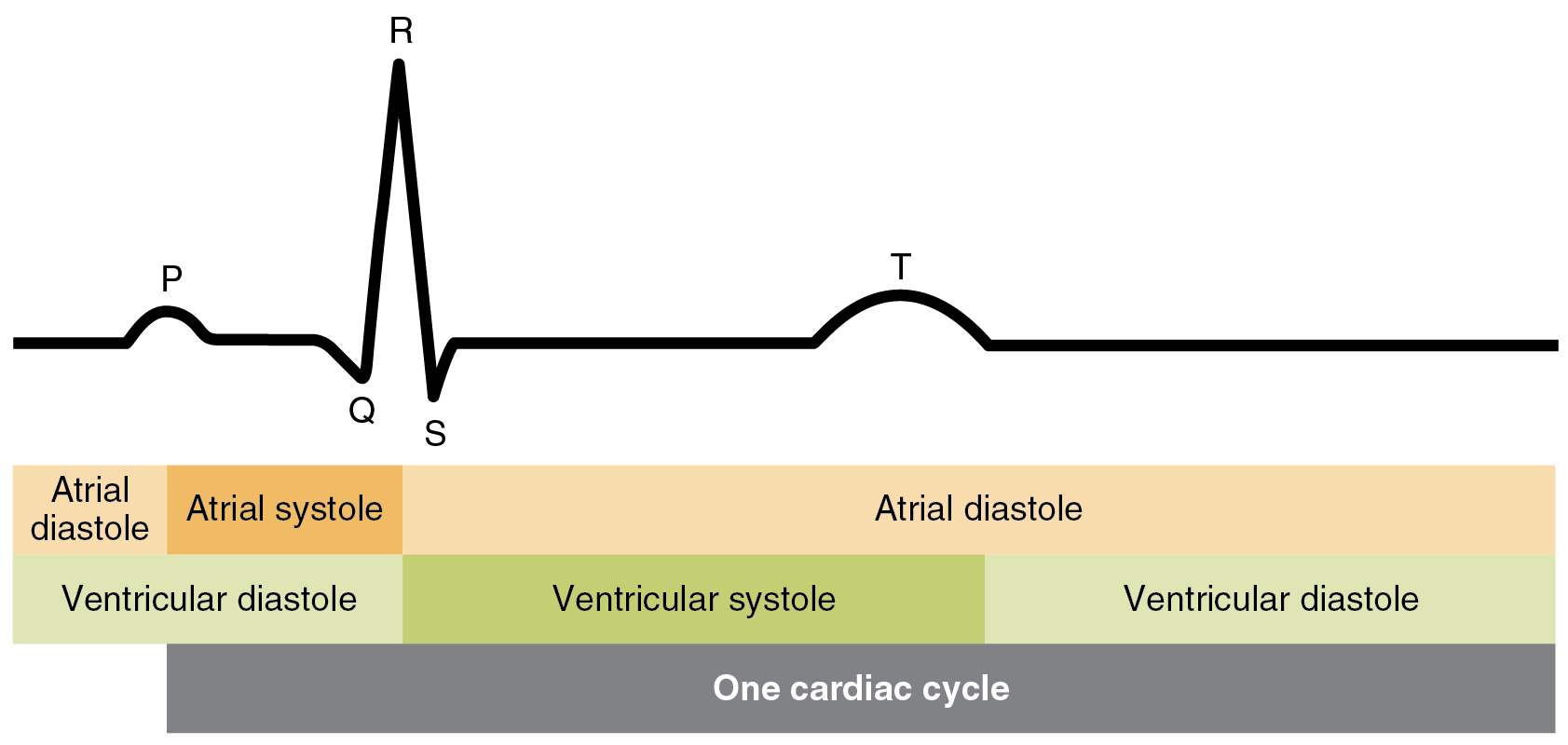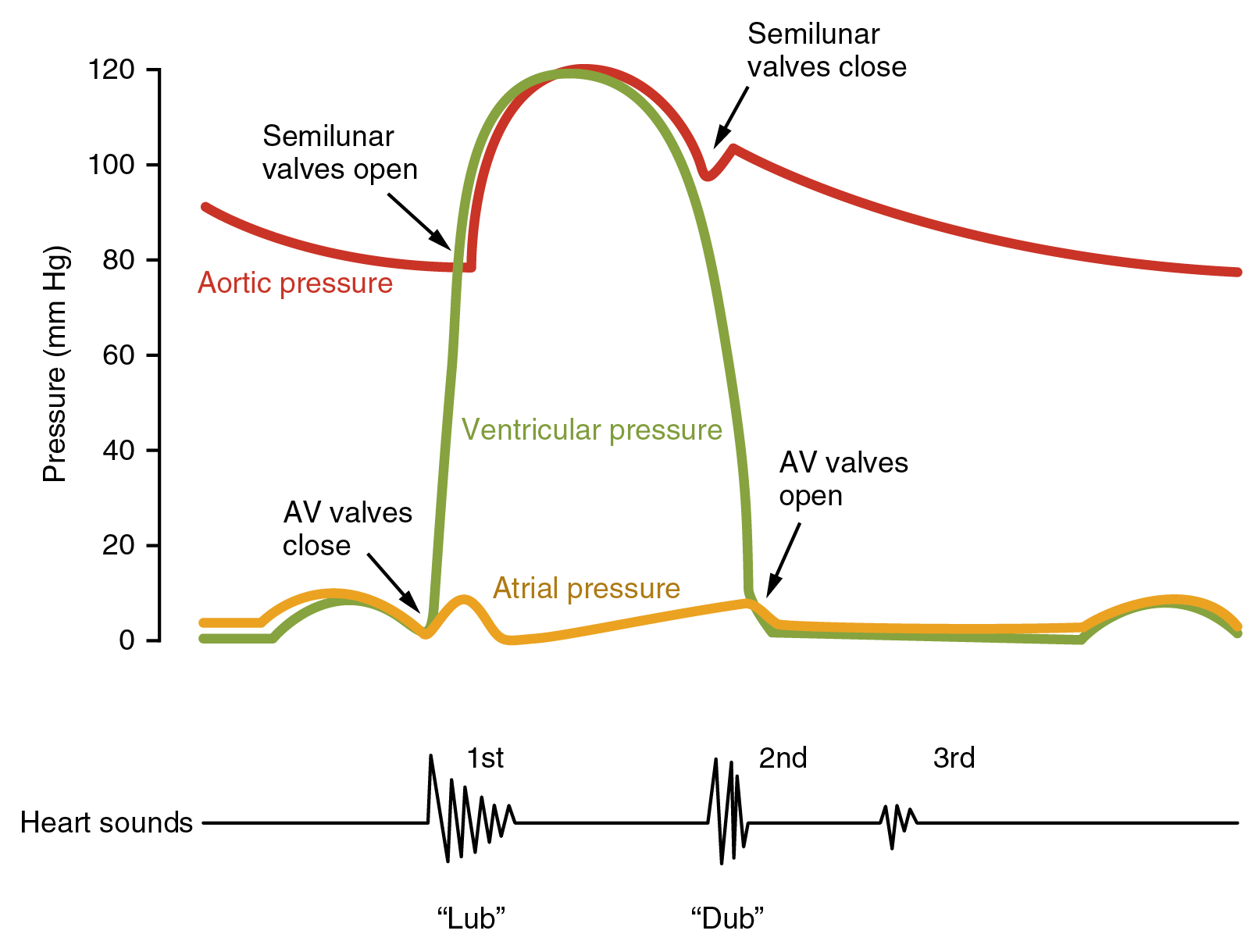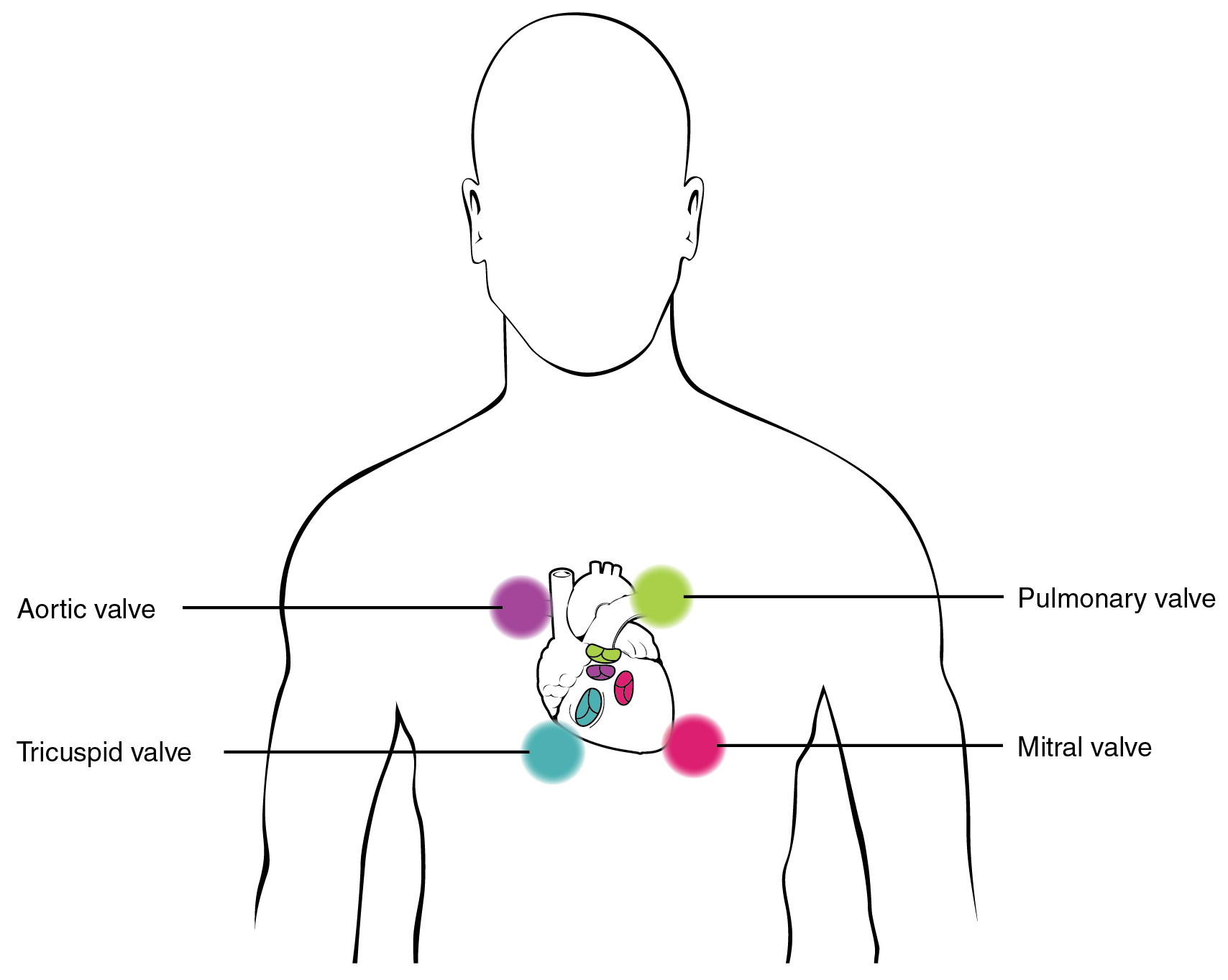what happens to the pressure of the blood in the ventricle when the ventricle myocardium relaxes?
The Cardiovascular Arrangement: The Center
Cardiac Bike
Learning Objectives
By the end of this section, you will be able to:
- Describe the relationship between blood pressure and blood flow
- Summarize the events of the cardiac wheel
- Compare atrial and ventricular systole and diastole
- Relate center sounds detected by auscultation to action of heart's valves
The menstruation of time that begins with contraction of the atria and ends with ventricular relaxation is known as the cardiac cycle ((Figure)). The period of contraction that the heart undergoes while it pumps blood into apportionment is called systole. The period of relaxation that occurs as the chambers make full with blood is chosen diastole. Both the atria and ventricles undergo systole and diastole, and information technology is essential that these components be carefully regulated and coordinated to ensure blood is pumped efficiently to the body.
Overview of the Cardiac Cycle
The cardiac bike begins with atrial systole and progresses to ventricular systole, atrial diastole, and ventricular diastole, when the wheel begins again. Correlations to the ECG are highlighted.

Pressures and Flow
Fluids, whether gases or liquids, are materials that menstruum according to pressure gradients—that is, they move from regions that are higher in pressure to regions that are lower in pressure. Accordingly, when the heart chambers are relaxed (diastole), blood will catamenia into the atria from the veins, which are higher in pressure. As blood flows into the atria, the pressure level will rise, so the blood volition initially move passively from the atria into the ventricles. When the action potential triggers the muscles in the atria to contract (atrial systole), the pressure within the atria rises further, pumping blood into the ventricles. During ventricular systole, pressure rises in the ventricles, pumping blood into the pulmonary torso from the right ventricle and into the aorta from the left ventricle. Once again, as yous consider this flow and relate it to the conduction pathway, the elegance of the system should become apparent.
Phases of the Cardiac Cycle
At the beginning of the cardiac cycle, both the atria and ventricles are relaxed (diastole). Claret is flowing into the right atrium from the superior and inferior venae cavae and the coronary sinus. Blood flows into the left atrium from the four pulmonary veins. The two atrioventricular valves, the tricuspid and mitral valves, are both open, and then blood flows unimpeded from the atria and into the ventricles. Approximately 70–eighty pct of ventricular filling occurs by this method. The two semilunar valves, the pulmonary and aortic valves, are closed, preventing backflow of blood into the correct and left ventricles from the pulmonary torso on the correct and the aorta on the left.
Atrial Systole and Diastole
Contraction of the atria follows depolarization, represented by the P moving ridge of the ECG. As the atrial muscles contract from the superior portion of the atria toward the atrioventricular septum, pressure level rises within the atria and blood is pumped into the ventricles through the open atrioventricular (tricuspid, and mitral or bicuspid) valves. At the showtime of atrial systole, the ventricles are normally filled with approximately lxx–eighty percent of their capacity due to inflow during diastole. Atrial contraction, too referred to as the "atrial kick," contributes the remaining xx–30 percent of filling (run into (Figure)). Atrial systole lasts approximately 100 ms and ends prior to ventricular systole, as the atrial muscle returns to diastole.
Ventricular Systole
Ventricular systole (see (Effigy)) follows the depolarization of the ventricles and is represented by the QRS complex in the ECG. It may be conveniently divided into two phases, lasting a total of 270 ms. At the end of atrial systole and just prior to atrial contraction, the ventricles comprise approximately 130 mL blood in a resting developed in a standing position. This volume is known equally the end diastolic volume (EDV) or preload.
Initially, as the muscles in the ventricle contract, the pressure of the blood within the chamber rises, but it is non nonetheless high plenty to open the semilunar (pulmonary and aortic) valves and be ejected from the center. However, blood pressure quickly rises above that of the atria that are now relaxed and in diastole. This increment in pressure causes blood to flow dorsum toward the atria, closing the tricuspid and mitral valves. Since blood is non beingness ejected from the ventricles at this early on stage, the book of blood inside the bedchamber remains constant. Consequently, this initial phase of ventricular systole is known equally isovolumic contraction, also called isovolumetric wrinkle (meet (Effigy)).
In the second phase of ventricular systole, the ventricular ejection phase, the contraction of the ventricular muscle has raised the force per unit area inside the ventricle to the point that it is greater than the pressures in the pulmonary trunk and the aorta. Blood is pumped from the eye, pushing open the pulmonary and aortic semilunar valves. Pressure generated past the left ventricle will be appreciably greater than the force per unit area generated past the right ventricle, since the existing pressure in the aorta will be so much higher. Nevertheless, both ventricles pump the same amount of claret. This quantity is referred to equally stroke book. Stroke volume will commonly be in the range of seventy–80 mL. Since ventricular systole began with an EDV of approximately 130 mL of blood, this means that there is however fifty–60 mL of blood remaining in the ventricle following contraction. This volume of blood is known as the terminate systolic volume (ESV).
Ventricular Diastole
Ventricular relaxation, or diastole, follows repolarization of the ventricles and is represented by the T wave of the ECG. It too is divided into ii distinct phases and lasts approximately 430 ms.
During the early phase of ventricular diastole, equally the ventricular muscle relaxes, pressure on the remaining blood within the ventricle begins to fall. When pressure level within the ventricles drops below force per unit area in both the pulmonary torso and aorta, blood flows back toward the middle, producing the dicrotic notch (small dip) seen in blood pressure tracings. The semilunar valves shut to forbid backflow into the heart. Since the atrioventricular valves remain airtight at this point, in that location is no modify in the volume of blood in the ventricle, then the early phase of ventricular diastole is called the isovolumic ventricular relaxation stage, likewise called isovolumetric ventricular relaxation phase (run across (Figure)).
In the 2d stage of ventricular diastole, called tardily ventricular diastole, as the ventricular muscle relaxes, force per unit area on the blood inside the ventricles drops even further. Somewhen, it drops below the pressure in the atria. When this occurs, blood flows from the atria into the ventricles, pushing open the tricuspid and mitral valves. As pressure drops within the ventricles, blood flows from the major veins into the relaxed atria and from at that place into the ventricles. Both chambers are in diastole, the atrioventricular valves are open up, and the semilunar valves remain closed (encounter (Figure)). The cardiac cycle is complete.
(Figure) illustrates the relationship between the cardiac cycle and the ECG.
Relationship between the Cardiac Bicycle and ECG
Initially, both the atria and ventricles are relaxed (diastole). The P wave represents depolarization of the atria and is followed past atrial wrinkle (systole). Atrial systole extends until the QRS complex, at which point, the atria relax. The QRS complex represents depolarization of the ventricles and is followed by ventricular contraction. The T wave represents the repolarization of the ventricles and marks the start of ventricular relaxation.

Centre Sounds
Ane of the simplest, all the same effective, diagnostic techniques applied to assess the state of a patient's eye is auscultation using a stethoscope.
In a normal, healthy heart, there are but 2 audible heart sounds: Sane and S2. Due south1 is the sound created by the closing of the atrioventricular valves during ventricular contraction and is normally described as a "lub," or first middle sound. The second heart sound, S2, is the sound of the closing of the semilunar valves during ventricular diastole and is described as a "dub" ((Effigy)). In both cases, every bit the valves shut, the openings within the atrioventricular septum guarded past the valves will become reduced, and blood period through the opening will become more turbulent until the valves are fully closed. At that place is a 3rd heart sound, S3, simply it is rarely heard in salubrious individuals. It may be the sound of blood flowing into the atria, or blood sloshing back and forth in the ventricle, or even tensing of the chordae tendineae. Due souththree may exist heard in youth, some athletes, and significant women. If the sound is heard later in life, it may indicate congestive eye failure, warranting further tests. Some cardiologists refer to the commonage S1, S2, and Southiii sounds equally the "Kentucky gallop," because they mimic those produced past a galloping horse. The fourth heart sound, Due southfour, results from the contraction of the atria pushing blood into a stiff or hypertrophic ventricle, indicating failure of the left ventricle. Sfour occurs prior to S1 and the collective sounds Sfour, South1, and Sii are referred to by some cardiologists every bit the "Tennessee gallop," considering of their similarity to the sound produced by a galloping horse with a different gait. A few individuals may have both Siii and S4, and this combined sound is referred to as S7.
Middle Sounds and the Cardiac Cycle
In this illustration, the x-axis reflects time with a recording of the heart sounds. The y-axis represents pressure.

The term murmur is used to draw an unusual audio coming from the heart that is caused by the turbulent menses of blood. Murmurs are graded on a scale of 1 to 6, with ane being the most common, the most difficult sound to observe, and the to the lowest degree serious. The most severe is a 6. Phonocardiograms or auscultograms can be used to record both normal and abnormal sounds using specialized electronic stethoscopes.
During auscultation, it is common practise for the clinician to ask the patient to exhale deeply. This procedure non only allows for listening to airflow, but it may also amplify heart murmurs. Inhalation increases blood flow into the right side of the centre and may increase the amplitude of right-sided center murmurs. Expiration partially restricts blood flow into the left side of the heart and may dilate left-sided heart murmurs. (Effigy) indicates proper placement of the bell of the stethoscope to facilitate auscultation.
Stethoscope Placement for Auscultation
Proper placement of the bong of the stethoscope facilitates auscultation. At each of the four locations on the chest, a different valve tin be heard.

Chapter Review
The cardiac cycle comprises a complete relaxation and contraction of both the atria and ventricles, and lasts approximately 0.8 seconds. Get-go with all chambers in diastole, blood flows passively from the veins into the atria and past the atrioventricular valves into the ventricles. The atria begin to contract (atrial systole), following depolarization of the atria, and pump blood into the ventricles. The ventricles begin to contract (ventricular systole), raising pressure inside the ventricles. When ventricular pressure rises above the force per unit area in the atria, blood flows toward the atria, producing the first heart sound, Southane or lub. As pressure in the ventricles rises above two major arteries, blood pushes open the 2 semilunar valves and moves into the pulmonary body and aorta in the ventricular ejection phase. Following ventricular repolarization, the ventricles begin to relax (ventricular diastole), and pressure within the ventricles drops. As ventricular pressure level drops, there is a tendency for blood to flow back into the atria from the major arteries, producing the dicrotic notch in the ECG and closing the two semilunar valves. The second heart sound, Southward2 or dub, occurs when the semilunar valves close. When the force per unit area falls below that of the atria, blood moves from the atria into the ventricles, opening the atrioventricular valves and marking i complete heart bicycle. The valves prevent backflow of claret. Failure of the valves to operate properly produces turbulent blood flow within the heart; the resulting heart murmur can often be heard with a stethoscope.
Review Questions
The cardiac cycle consists of a distinct relaxation and contraction phase. Which term is typically used to refer ventricular wrinkle while no claret is existence ejected?
- systole
- diastole
- quiescent
- isovolumic wrinkle
Most blood enters the ventricle during ________.
- atrial systole
- atrial diastole
- ventricular systole
- isovolumic contraction
The first heart audio represents which portion of the cardiac bike?
- atrial systole
- ventricular systole
- closing of the atrioventricular valves
- closing of the semilunar valves
Ventricular relaxation immediately follows ________.
- atrial depolarization
- ventricular repolarization
- ventricular depolarization
- atrial repolarization
Critical Thinking Questions
Depict 1 cardiac wheel, beginning with both atria and ventricles relaxed.
The cardiac cycle comprises a complete relaxation and wrinkle of both the atria and ventricles, and lasts approximately 0.8 seconds. Commencement with all chambers in diastole, blood flows passively from the veins into the atria and past the atrioventricular valves into the ventricles. The atria brainstorm to contract following depolarization of the atria and pump blood into the ventricles. The ventricles brainstorm to contract, raising force per unit area inside the ventricles. When ventricular pressure level rises above the pressure in the two major arteries, blood pushes open the two semilunar valves and moves into the pulmonary trunk and aorta in the ventricular ejection phase. Following ventricular repolarization, the ventricles begin to relax, and pressure within the ventricles drops. When the force per unit area falls below that of the atria, blood moves from the atria into the ventricles, opening the atrioventricular valves and marking one complete heart cycle.
Glossary
- cardiac cycle
- period of time between the onset of atrial contraction (atrial systole) and ventricular relaxation (ventricular diastole)
- diastole
- menses of time when the heart musculus is relaxed and the chambers fill with blood
- end diastolic volume (EDV)
- (also, preload) the corporeality of claret in the ventricles at the end of atrial systole just prior to ventricular contraction
- end systolic volume (ESV)
- corporeality of blood remaining in each ventricle following systole
- heart sounds
- sounds heard via auscultation with a stethoscope of the closing of the atrioventricular valves ("lub") and semilunar valves ("dub")
- isovolumic wrinkle
- (also, isovolumetric contraction) initial phase of ventricular contraction in which tension and pressure level in the ventricle increment, but no blood is pumped or ejected from the eye
- isovolumic ventricular relaxation stage
- initial phase of the ventricular diastole when pressure in the ventricles drops below force per unit area in the two major arteries, the pulmonary body, and the aorta, and blood attempts to flow back into the ventricles, producing the dicrotic notch of the ECG and closing the two semilunar valves
- murmur
- unusual heart sound detected past auscultation; typically related to septal or valve defects
- preload
- (also, end diastolic volume) amount of blood in the ventricles at the stop of atrial systole just prior to ventricular contraction
- systole
- period of time when the eye muscle is contracting
- ventricular ejection phase
- second stage of ventricular systole during which blood is pumped from the ventricle
mousersairenecons1995.blogspot.com
Source: https://opentextbc.ca/anatomyandphysiologyopenstax/chapter/cardiac-cycle/
0 Response to "what happens to the pressure of the blood in the ventricle when the ventricle myocardium relaxes?"
Post a Comment